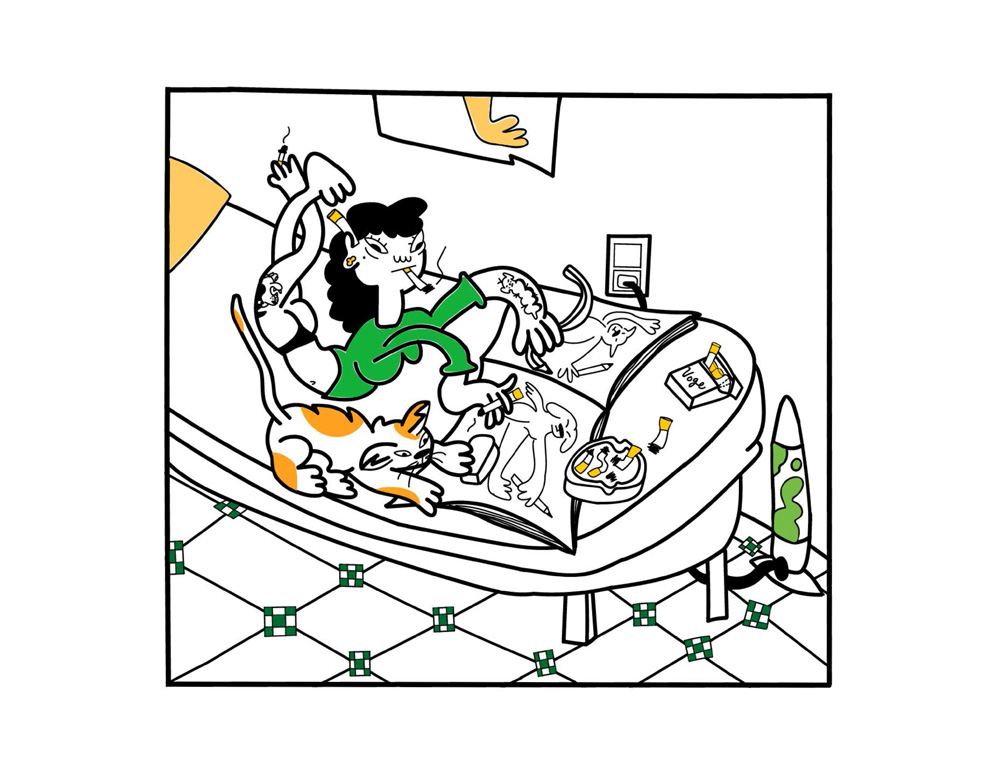Judith Trench
Year of birth: 1997.
Where do you live: Barcelona.
Your education: Degree in Comunicación e Industrias Culturales (Universidad de Barcelona) and Postdegree in Ilustración Narrativa para publicaciones Infantiles y Juveniles.
Describe your art in three words: minimal, cartoonish and playful.
Your discipline: Illustration.
Instagram
 What inspired you to dedicate yourself to both illustration and journalism?
What inspired you to dedicate yourself to both illustration and journalism?
For as long as I can remember, I have been obsessed with the world of books, films and music. Everything else has somehow been left in the background, so I knew that my future (working or not working) was there: the creation of images or texts.
My initial idea was to dedicate in to writing in-depth articles and chronicles, but later I realized that I felt more comfortable expressing myself with drawings and not with words. The echo of writing anything makes me feel ashamed, as if I were very exposed. With illustration it is the other way around, it allows me to uninhibit myself. I do not rule out dedicating myself to cultural journalism and adding my sketches to the written pieces. It would be an interesting differentiating point.
How does your training in children’s and young adult narrative illustration influence your current projects?
I started recently so I don’t have a very extensive background. What I am clear about is the type of book I want to make. I just finished my first project for children (early readers). The project is called “The Six Pastry Chefs” and it is a very short and funny story about making a cake for a person who is not expecting it. Now I have to find the publisher that fits with this type of story. And with a bit of luck more books will come!
Can you explain your creative process when working on an illustration?
For me the most important thing when drawing is to be in a state of calm. I don’t like to have any expectations because that slows me down and makes me doubt. Many times the dirtiest and most absurd sketches are the ones that I finally polish and become the final art.
I try to use few photographic references because I like my drawings to be far from reality. Once I have a clear idea of the assignment or personal project, the sketching process begins. Then, after many discards and collages, I use that same line in two ways: either I respect the line and redraw it with the same pencil and with more force, or I outline it digitally. Finally, I choose the color palette, which is usually a fairly intuitive process for me, and I move on to coloring the necessary elements. I try to use few colors in the same image, since this way the characters remain the total protagonists of the image.
What are some of the challenges you face in the illustration industry, especially in the children’s and young adult book niche?
I think that the important thing is to have your own voice, but that is not enough. You have to find someone who “finds” you, and that process can take a long time. Apart from drawing every day, it is important to be in contact with the industry, whether through teachers, talks, colleagues, etc.
 What do you think are the key elements of a successful children’s book illustration?
What do you think are the key elements of a successful children’s book illustration?
The key element would be to illustrate honestly. Look for alternative paths and really make the book you want to make, without asking permission or forgiveness.
Who are some illustrators or artists who have influenced your style?
Bill Plymptom in terms of the deformation of anatomies. Bastien Vives for his delicacy, although my drawings are not characterized by that adjective. The Simpsons for their color treatment. Lastly Lisa Hanawalt for her humor and quirkiness.
What advice would you give to aspiring illustrators who want to work in the field of children’s and young adult literature?
To stay firm in their vision. I repeat this to myself every day. Also to be inspired by external references but to know when to stop. With the avalanche of images we have available it is easy to get confused and think that everything is done.



Leave a Reply